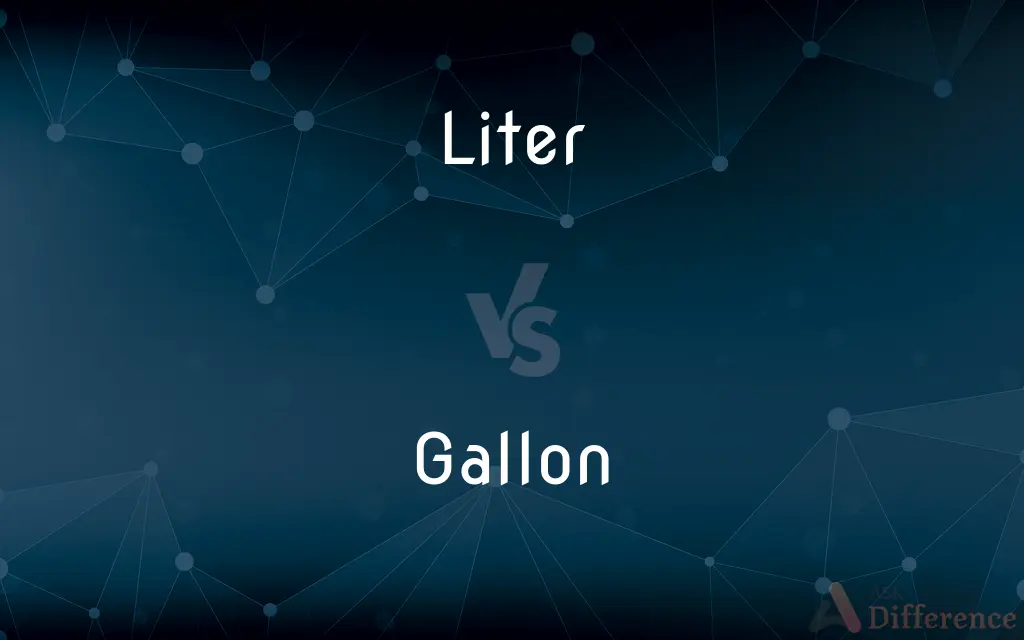Liter vs. Gallon — What's the Difference?
By Fiza Rafique & Maham Liaqat — Updated on March 15, 2024
A liter is a metric unit of volume, while a gallon is a customary unit used primarily in the US.

Difference Between Liter and Gallon
Table of Contents
ADVERTISEMENT
Key Differences
Liters are part of the metric system, commonly used worldwide for measuring volume, especially in scientific and standard everyday contexts. Gallons, on the other hand, are used predominantly in the United States for larger volumes, particularly for liquids like gasoline and milk.
One liter is defined as the volume of one kilogram of water at its maximum density, which occurs at about 4°C. A gallon, however, has different definitions in the US and the UK; in the US, one gallon is equivalent to approximately 3.785 liters, showcasing a significant difference in volume.
The use of liters is widespread in industries such as beverages, automotive (engine displacement, fuel efficiency), and packaging, due to its global standardization. Conversely, gallons are frequently used in the US for domestic purposes, such as fuel economy ratings for vehicles, and in the UK for selling road fuel.
Understanding the conversion between liters and gallons is crucial for activities like international travel, cooking, and automotive maintenance, especially when dealing with fuel volumes and engine specifications.
Comparison Chart
System
Metric
US Customary (also Imperial in UK)
ADVERTISEMENT
Volume
1 liter is 1,000 cubic centimeters (cm³).
1 US gallon is approximately 3.785 liters.
Usage
Widespread globally, scientific standards.
Predominantly in the US, for liquids.
Definition Basis
Volume of 1 kg of water at maximum density.
Defined historically by wine gallon in US.
Common Applications
Beverages, automotive, packaging.
Fuel economy, domestic liquid measurements.
Compare with Definitions
Liter
Integral in cooking and recipe measurements outside the US.
The recipe calls for 1.5 liters of water.
Gallon
Used in various industries for bulk liquid measurements.
The paint is sold in 5-gallon buckets.
Liter
Used worldwide for scientific and commercial measurements.
The car's fuel efficiency is measured in liters per 100 kilometers.
Gallon
A unit of volume for liquid measure equal to four quarts, used in the US.
She bought a gallon of milk.
Liter
Metric unit of volume equal to 1,000 cubic centimeters.
The bottle has a capacity of 2 liters.
Gallon
Common in fuel economy measurements in the US.
His truck gets 20 miles per gallon.
Liter
Basis for derived metric units, like milliliter.
That medicine dose is 50 milliliters, or 0.05 liters.
Gallon
Historically varied in size, now standardized in US and UK.
The UK imperial gallon is larger than the US gallon.
Liter
Standard volume unit for liquids and gases.
The engine's displacement is 1.8 liters.
Gallon
Can be subdivided into quarts, pints, and cups in customary systems.
Half a gallon equals 2 quarts or 8 cups.
Liter
A metric unit of volume equal to approximately 1.056 liquid quarts, 0.908 dry quart, or 0.264 gallon. See Table at measurement.
Gallon
The gallon is a unit of volume in imperial units and United States customary units. Three different versions are in current use: the imperial gallon (imp gal), defined as 4.546 09 litres, which is used in the United Kingdom, Canada, and some Caribbean countries; the US gallon (US gal) defined as 231 cubic inches (exactly 3.785 411 784 litres), which is used in the US and some Latin American and Caribbean countries; and the US dry gallon ("usdrygal"), defined as 1/8 US bushel (exactly 4.404 883 770 86 litres).There are four quarts in a gallon and eight pints in a gallon, which have different volumes in different systems.
Liter
(American spelling) litre, one cubic decimeter.
Gallon
A unit of volume in the US Customary System, used in liquid measure, equal to 4 quarts (3.785 liters).
Liter
A measure of capacity in the metric system, being a cubic decimeter, equal to 61.022 cubic inches, or 2.113 American pints, or 1.76 English pints.
Gallon
A unit of volume in the British Imperial System, used in liquid and dry measure, equal to 4 quarts (4.546 liters). See Table at measurement.
Liter
A metric unit of capacity equal to the volume of 1 kilogram of pure water at 4 degrees centigrade and 760 mm of mercury (or approximately 1.76 pints)
Gallon
A container with a capacity of one gallon.
Gallon
The contents of such a container.
Gallon
A unit of volume, equivalent to eight pints
Gallon
Exactly 4.54609 liters; an imperial gallon
Gallon
(US) 231 cubic inches or approximately 3.785 liters for liquids (a "U.S. liquid gallon")
Gallon
(US) one-eighth of a U.S. bushel or approximately 4.405 liters for dry goods (a "U.S. dry gallon").
Gallon
A large quantity (of any liquid).
The pipe burst and gallons of water flooded into the kitchen.
Gallon
A measure of capacity, containing four quarts; - used, for the most part, in liquid measure, but sometimes in dry measure.
Gallon
United States liquid unit equal to 4 quarts or 3.785 liters
Gallon
A British imperial capacity measure (liquid or dry) equal to 4 quarts or 4.545 liters
Common Curiosities
Can the liter and gallon be used interchangeably?
They can be converted, but due to their significant volume difference, they are not directly interchangeable without calculation.
How many liters are in a gallon?
One US gallon is approximately 3.785 liters.
Where is the liter commonly used?
The liter is used worldwide for scientific, commercial, and everyday volume measurements.
How is fuel efficiency measured in liters?
Fuel efficiency can be measured in liters per 100 kilometers in many countries, indicating how many liters of fuel are used to travel 100 kilometers.
What is a liter?
A liter is a metric unit of volume, equal to 1,000 cubic centimeters.
What is a gallon?
A gallon is a unit of volume used primarily in the US for liquid measurements, equal to four quarts.
Why are liters preferred in scientific contexts?
Liters are part of the metric system, which is globally standardized and scientifically preferred for precision.
Is the liter a base unit in the metric system?
The liter is not a base unit in the International System of Units (SI), but it is an accepted unit for volume.
What is the historical basis for the gallon?
The gallon has various historical definitions, but in the US, it was historically defined based on the wine gallon.
Is the gallon used outside the US?
Yes, the UK also uses gallons, but the UK gallon is larger than the US gallon.
Are food and beverages measured in gallons or liters?
In the US, gallons, quarts, pints, and cups are often used, while most other countries use liters and milliliters.
Do all countries use the same size gallon?
No, the US gallon and UK (Imperial) gallon are different in size.
Can engine displacement be measured in gallons?
Engine displacement is typically measured in liters, though older or specific contexts might use cubic inches.
How do you convert gallons to liters?
To convert gallons to liters, multiply the number of gallons by 3.785.
How does the use of liters and gallons affect international travel?
Travelers might need to convert between liters and gallons for activities like refueling rental cars or cooking.
Share Your Discovery

Previous Comparison
Implement vs. Configure
Next Comparison
Autecology vs. SynecologyAuthor Spotlight
Written by
Fiza RafiqueFiza Rafique is a skilled content writer at AskDifference.com, where she meticulously refines and enhances written pieces. Drawing from her vast editorial expertise, Fiza ensures clarity, accuracy, and precision in every article. Passionate about language, she continually seeks to elevate the quality of content for readers worldwide.
Co-written by
Maham Liaqat














































